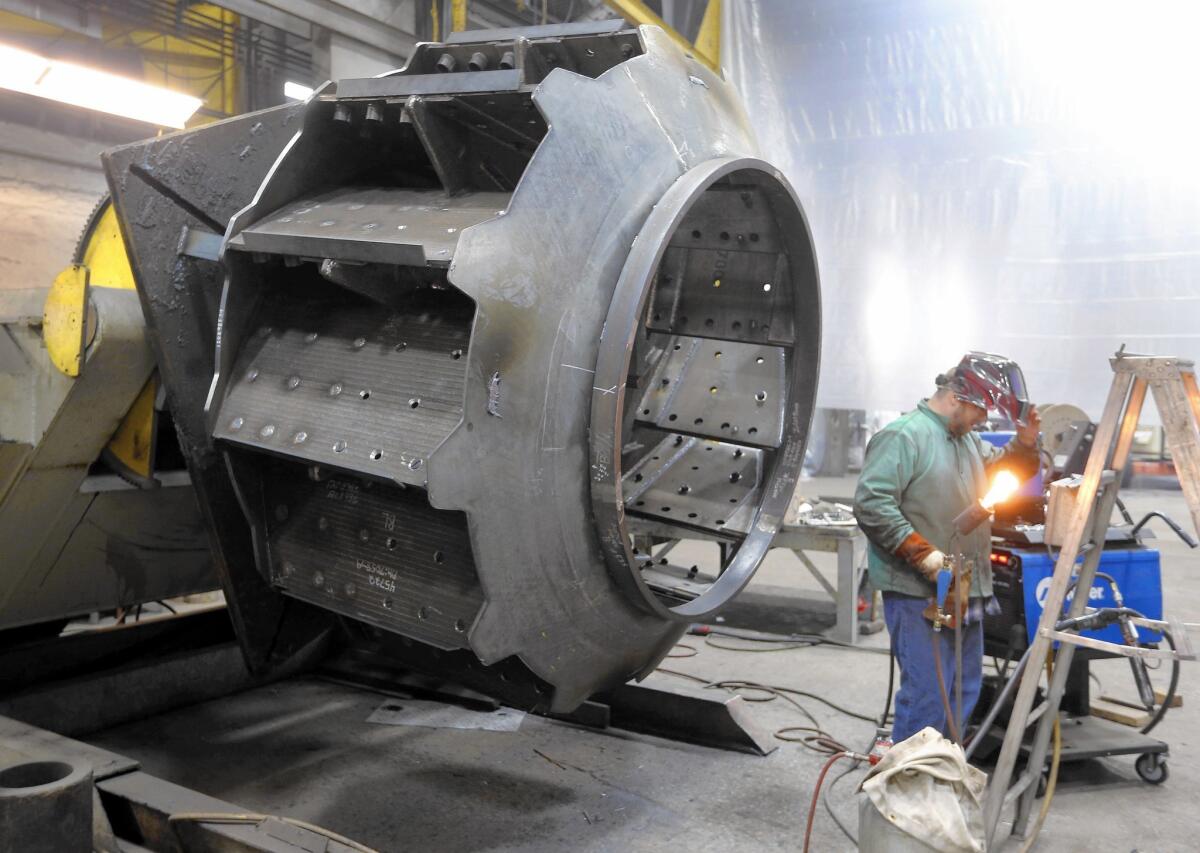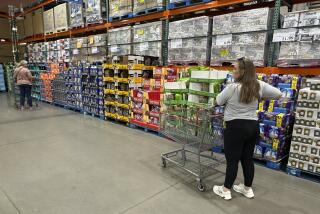GDP grew at 2.3% rate in 2nd quarter; 1st-quarter growth revised upward

A worker welds parts at Robinson Fans Inc. in Harmony, Pa., in February. Wage growth should accelerate as the labor market improves, giving workers more money to spend, an analyst said.
- Share via
Reporting from washington — The economy rebounded in the second quarter after a winter slowdown that was less severe than previously estimated, returning to the modest growth that has marked the slow recovery from the Great Recession.
Total economic output, also known as gross domestic product, increased at a 2.3% annual rate from April through June, the Commerce Department said Thursday. The figure — the first of three estimates by the government — fell short of economists’ forecasts of 2.9% annualized growth.
But that was partly offset by new data showing the economy did not contract in the first quarter as originally reported.
Taken together, the growth in the first half of the year probably keeps Federal Reserve policymakers on track to hike their benchmark interest rate in September, analysts said.
“The economy seems to be gathering momentum,” said Scott Hoyt, senior director of consumer economics at Moody’s Analytics.
“We clearly have gotten past some of the hurdles that slowed things down at the start of the year,” he said.
Unusually bad winter weather, a labor dispute at West Coast ports and lower energy prices combined to hinder growth in the first quarter of the year.
However, the hit was not nearly as bad as initially believed.
The economy expanded at a 0.6% annual rate from January through March, the Commerce Department said in its final estimate for the quarter.
That was a major improvement from the 0.2% annualized contraction in a report last month and a first estimate of a 0.7% contraction.
Taken together, the new data indicate that the economy expanded at about a 1.5% annual rate in the first half of the year. The weak performance is well below the economy’s potential and worse than last year’s tepid 1.9% first-half growth.
“It was a little disappointing there wasn’t a bigger bounce back from the first quarter; 0.6% is still extremely low,” said Gad Levanon, an economist at the Conference Board.
He’s forecasting further improvement in the second half of the year, with economic growth of 2.5%. The improving housing and labor markets will help boost consumer spending, he said.
The stronger second-quarter growth was fueled by an increase in exports, consumer purchases and spending by state and local governments.
Exports, which have been hurt by a rising dollar, increased 5.3% from April through June after they had plunged 6% in the first quarter.
Consumer spending rose 2.9% in the second quarter, up from a weak 1.8% rise in the previous quarter, and state and local governments increased their spending by 2% after a 0.8% decrease in the first quarter.
Wage growth should accelerate as the labor market improves, giving workers more money to spend, Hoyt said.
“Happier consumers with more income should generate more spending,” he said.
The Labor Department said initial claims for unemployment last week rose 12,000, to 267,000. But the figure, which can be volatile week-to-week, remains historically low and analysts believe job growth was strong again this month.
Some economists anticipated an upward revision of first-quarter growth, saying the initial estimates were dragged down because of problems with the way the Commerce Department calculates seasonal changes.
On Thursday, as part of its annual revisions of data, the department’s Bureau of Economic Analysis said it was introducing new seasonal adjustment methods for key categories such as federal defense spending and consumer spending on services.
The revisions also showed that growth was weaker from 2011 to 2014 than originally reported. The economy expanded at an average annual rate of 2% during that period, down from an earlier estimate of 2.3%.
More to Read
Inside the business of entertainment
The Wide Shot brings you news, analysis and insights on everything from streaming wars to production — and what it all means for the future.
You may occasionally receive promotional content from the Los Angeles Times.











